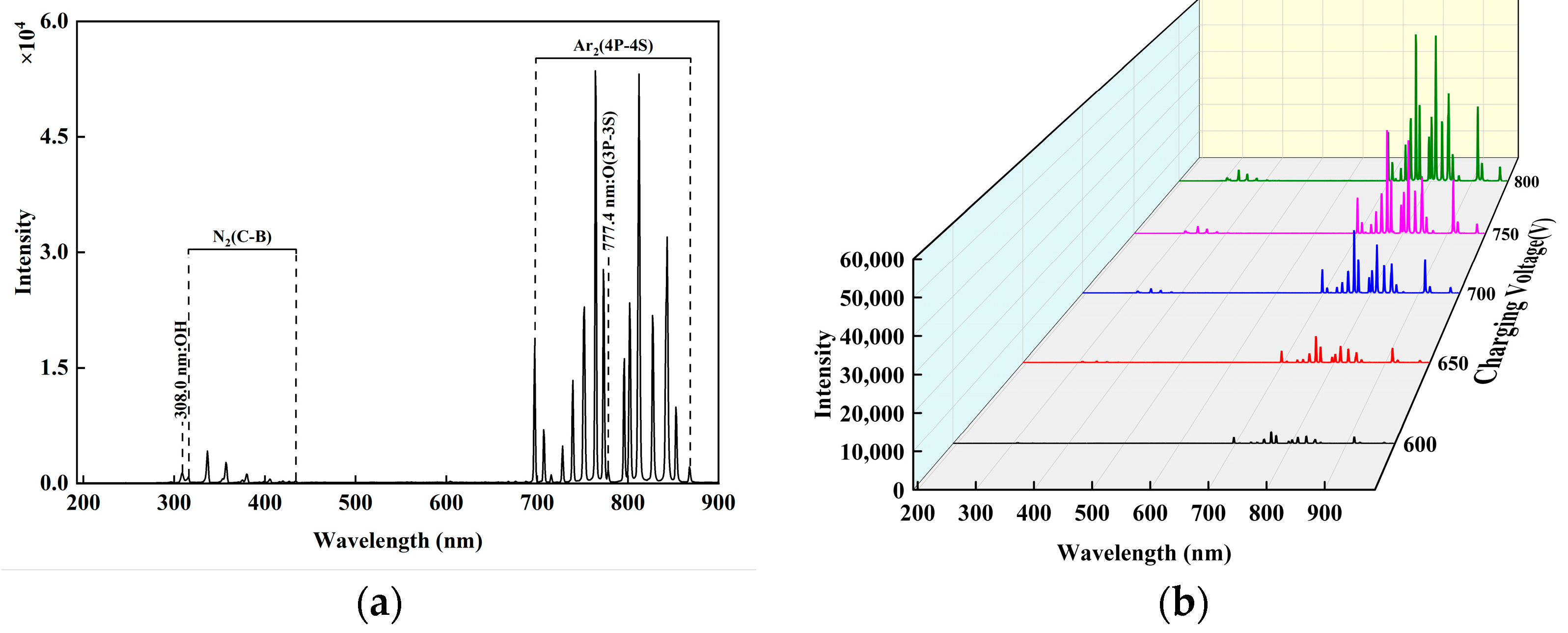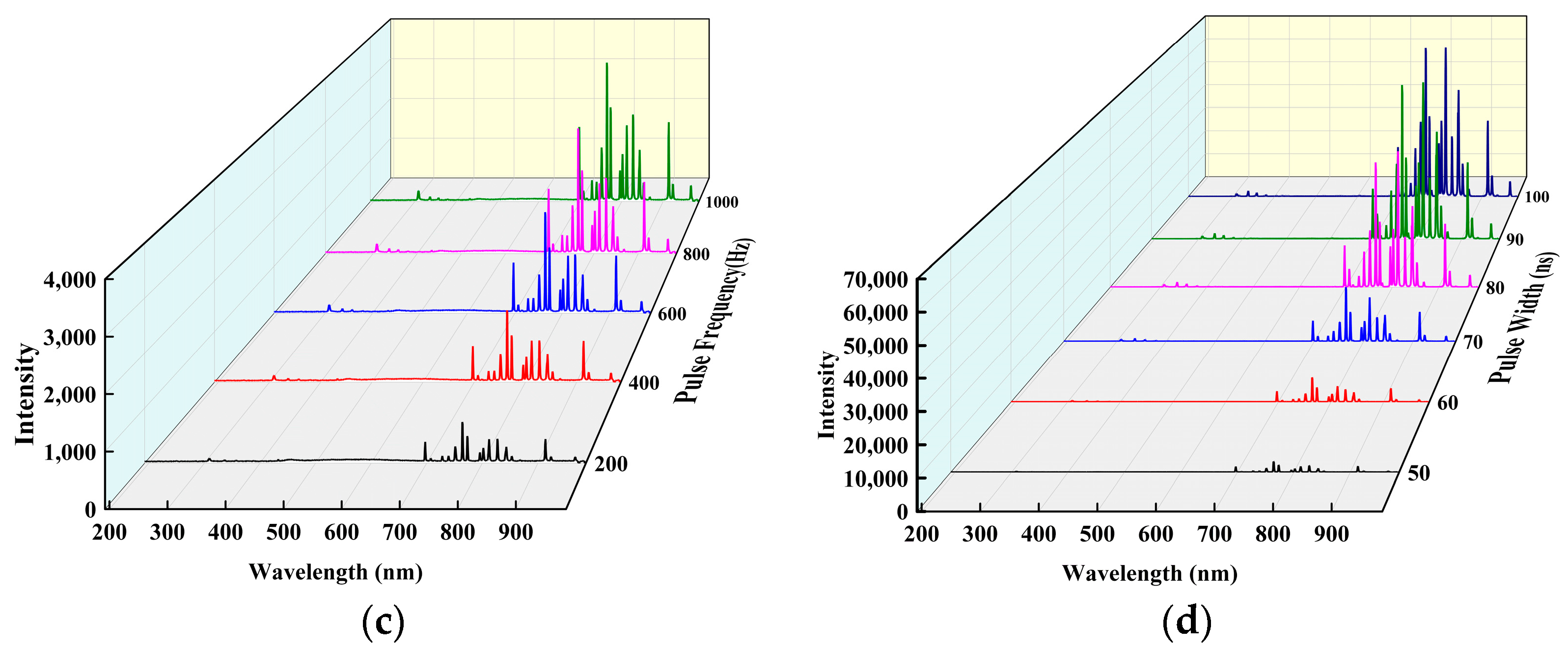Research on Solid-State Linear Transformer Driver Power Source Driving Atmospheric Pressure Plasma Jet Treatment of Epoxy Resin
Abstract
1. Introduction
2. Experimental Setup and Measurements
2.1. Principles and Design of SSLTD
2.2. Experimental Method
3. Experimental Results Analysis and Discussion
3.1. Performance Testing of SSLTD
3.2. Optical Characteristics of Atmospheric Pressure Plasma Jet Driven by SSLTD
3.3. Analysis of Typical Properties of Epoxy Resin Treated by Atmospheric Pressure Plasma Jet
4. Conclusions
- (1)
- The designed 15-stage SSLTD can stably output nanosecond pulse voltages with an amplitude 15 times the charging voltage under high-frequency conditions, with a rise time of approximately ten nanoseconds, making it suitable for plasma discharge.
- (2)
- The SSLTD successfully excited stable Ar plasma jets with temperatures ranging between approximately 26 and 33 °C and electron densities in the range of 1015~1016 cm−3, which can effectively interact with material surfaces while avoiding excessive plasma jet intensity that could damage the materials and affect the final modification outcome.
- (3)
- In the modification process of the argon plasma jet excited by SSLTD, the increase in pulse frequency primarily affects the central part of the modified region, resulting in a more uniform modification effect. In contrast, increases in charging voltage and pulse width promote the outward expansion of the modified region. After modification, the dielectric breakdown resistance of the epoxy resin surface is significantly enhanced. Optimal modification effects are observed at a charging voltage of 600 V, a pulse width of 50 ns, and a pulse frequency within the range of 800 to 1000 Hz.
Author Contributions
Funding
Data Availability Statement
Conflicts of Interest
References
- Shao, T.; Zhang, C.; Wang, R.; Yan, P.; Ren, C. Atmospheric-pressure Pulsed Gas Discharge and Pulsed Plasma Application. High Volt. Eng. 2016, 42, 685–705. [Google Scholar]
- Bhuiyan, S.I.; Wang, K.; Baky, M.A.H.; Kraus, J.; Jemison, H.; Staack, D. Controlling Parameters in the Efficiency of Hydrogen Production via Electrification with Multi-Phase Plasma Processing Technology. Energies 2023, 16, 5509. [Google Scholar] [CrossRef]
- Nastuta, A.V.; Asandulesa, M.; Doroftei, F.; Dascalu, I.-A.; Varganici, C.-D.; Tiron, V.; Topala, I. Atmospheric Pressure Plasma Jet Exposure of Polylactic Acid Surfaces for Better Adhesion: Plasma Parameters towards Polymer Properties. Polymers 2024, 16, 240. [Google Scholar] [CrossRef] [PubMed]
- Svarnas, P.; Poupouzas, M.; Papalexopoulou, K.; Kalaitzopoulou, E.; Skipitari, M.; Papadea, P.; Varemmenou, A.; Giannakopoulos, E.; Georgiou, C.D.; Georga, S.; et al. Water Modification by Cold Plasma Jet with Respect to Physical and Chemical Properties. Appl. Sci. 2022, 12, 11950. [Google Scholar] [CrossRef]
- Kikuchi, S.; Saiki, S.; Ohashi, T.; Nakazawa, K. Surface modification for steel rods based on atmospheric-pressure nitrogen plasma treatment at room temperature. Results Mater. 2024, 23, 100612. [Google Scholar] [CrossRef]
- Kang, H.; Lee, S.H.; Kim, K. Wettability of polytetrafluoroethylene surfaces by plasma etching modifications. PLoS ONE 2023, 18, 0282352. [Google Scholar] [CrossRef]
- Shen, J.; Zhou, Y.; Zhu, X.; Cui, X.; Fang, Z. Enhancement of Ceramic Hydrophobicity with Plasma Jet Excited by AC and Nanosecond Pulse Power Supply. Proc. CSEE 2022, 42, 8781–8791. [Google Scholar]
- Bunin, I.Z.; Khabarova, I.A. Comparative study on high-voltage nanosecond pulses and dielectric barrier discharge effects on surface morphology and physico-chemical properties of natural pyrrhotite. J. Phys. Conf. Ser. 2021, 2064, 012056. [Google Scholar] [CrossRef]
- Lada, Z.G.; Voyiatzis, G.A.; Aggelopoulos, C.A. A novel, green, low-cost regeneration method for surface enhanced raman scattering (SERS) solid substrates based on nanosecond pulsed cold plasma technology. Surf. Interfaces 2022, 34, 102330. [Google Scholar] [CrossRef]
- Attri, P.; Park, J.H.; Gaur, J.; Kumar, N.; Park, D.H.; Jeon, S.N.; Park, B.S.; Chand, S.; Uhm, H.S.; Choi, E.H. Influence of nanosecond pulsed plasma on the non-enzymatic pathway for the generation of nitric oxide from L-arginine and the modification of graphite oxide to increase the solar cell efficiency. Phys. Chem. Chem. Phys. 2014, 16, 18375–18382. [Google Scholar] [CrossRef]
- Zhang, C.; Zhou, Z.; Wang, R.; Shen, Y.; Shao, T.; Fang, Z. Modification of Copper Surface by Nanosecond-pulse Diffuse Discharges at Atmospheric Pressure. High Volt. Eng. 2015, 41, 1458–1465. [Google Scholar]
- Kazemi, M.R.; Sugai, T.; Tokuchi, A.; Jiang, W. Waveform control of pulsed-power generator based on solid-state LTD. IEEE Trans. Plasma Sci. 2017, 45, 247–251. [Google Scholar] [CrossRef]
- Holma, J.; Barnes, M.J. Measurements on a 20-layer 12.5 kV prototype inductive adder for the CLIC DR kickers. In Proceedings of the 2017 IEEE 21st International Conference on Pulsed Power (PPC), Brighton, UK, 18–22 June 2017; pp. 1–5. [Google Scholar]
- Woog, D.; Barnes, M.J.; Ducimetière, L.; Holma, J.; Kramer, T. Design of an inductive adder for the FCC injection kicker pulse generator. Physics 2017, 874, 012096. [Google Scholar] [CrossRef]
- Yu, F.; Sugai, T.; Tokuchi, A.; Jiang, W. Development of Solid-State LTD Module Using Silicon Carbide MOSFETs. IEEE Trans. Plasma Sci. 2019, 47, 5037–5041. [Google Scholar] [CrossRef]
- Jiang, W.; Sugiyama, H.; Tokuchi, A. Pulsed power generation by solid-state LTD. IEEE Trans. Plasma Sci. 2014, 11, 3603–3608. [Google Scholar] [CrossRef]
- Wang, Y.; Xu, L.; Jiang, S.; Li, Z.; Rao, J. Solid-State Linear Transformer Driver Based on Full-Bridge Bricks. IEEE Trans. Plasma Sci. 2022, 5, 1269–1275. [Google Scholar] [CrossRef]
- Jiang, W. High-frequency Repetitive LTD Based on Semiconductor Switches. High Volt. Eng. 2015, 41, 1776–1780. [Google Scholar]
- Zeng, W.; Yu, L.; Dong, S.; Ma, J.; Wang, Y.; He, Y.; Wang, X.; Yao, C. A Novel High-Frequency Bipolar Pulsed Power Generator for Biological Applications. IEEE Trans. Power Electron. 2020, 35, 12861–12870. [Google Scholar] [CrossRef]
- Zhao, S.; Hao, C.; Xu, D.; Wen, Y.; Qiu, J.; Liu, K. Effect of electrical parameters on energy yield of organic pollutant degradation in a dielectric barrier discharge reactor. IEEE Trans. Plasma Sci. 2017, 6, 1043–1050. [Google Scholar] [CrossRef]
- Feng, Y.; Mao, Y.; Luo, H.; Jiang, W. Performance test and analysisi based on solid-stste high repetitive frequency LTD. High Power Laser Part. Beams 2018, 30, 100–104. [Google Scholar]
- Yao, X.; Su, Z.; Gong, D.; Liu, R.; Li, X.; Liu, F.; Jia, P. Study on the Gas Temperature of Atmospheric Pressure Argon Plasma Jet by Spectroscopy. J. Hebei Norm. Univ. (Nat. Sci. Ed.) 2019, 43, 225–229. [Google Scholar]
- Tian, F.; Chen, L.; Pei, H.; Bai, J.; Zeng, W. Diagnostic study on jet emission spectroscopy of helium, methane and air plasma under atmospheric pressure. Spectrosc. Spectr. Anal. 2023, 43, 2694–2698. [Google Scholar]
- Guo, K.; Zhang, C.; Sun, J.; Chen, G.; Li, J.; Shao, T. Temporal Evolution Characteristics of Discharge Parameters in Insulating Oil Based on Optical Emission Spectra. High Volt. Eng. 2024, 50, 3191–3198. [Google Scholar]
- Feng, B.; Wang, R.; Ma, Y.; Zhong, X. Evolution of atmospheric needle-plate discharge plasma. Acta Phys. Sin. 2021, 70, 128–138. [Google Scholar] [CrossRef]
- Zeng, X.; Zhang, S.; Bai, H.; Zhang, C.; Shao, T. Electron density calculation of high-voltage discharge plasma based on atomic spectroscopy Stark. Proc. CSEE 2024, 44, 4579–4589. [Google Scholar]
- Pellerin, S.; Musiol, K.; Pokrzywka, B.; Chapelle, J. Stark width of 4p’[1/2]-4s [3/2]0 Ar I transition (696.543 nm). J. Phys. B-At. Mol. Opt. Phys. 1996, 29, 3911–3924. [Google Scholar] [CrossRef]









| Device | Model | Value | Numbers |
|---|---|---|---|
| MOSFET | C3M0160120J | 1200 V, 17 A | 10 |
| Driver-IC | IXDN630YI | 35 V, 30 A | 10 |
| Capacitor | C2220X164KFRL | 1500 V, 0.16μF | 30 |
| MagneticCore | 1k107 | Outer dia./innerdia./thickness130/86/8 (mm) | 1 |
| Optical Module | AFBR-2624Z | DC~50 Mbaud | 1 |
| Diode | SF1600 | 1600 V, 1 A (DC) | 4 |
| Charging Voltage (V) | 600 | 650 | 700 | 750 | 800 |
|---|---|---|---|---|---|
| Ne (cm−3) | 4.28 × 1015 | 6.24 × 1015 | 8.30 × 1015 | 9.78 × 1015 | 1.31 × 1016 |
| Pulse Frequency (Hz) | 200 | 400 | 600 | 800 | 1000 |
|---|---|---|---|---|---|
| Ne (cm−3) | 4.35 × 1015 | 3.94 × 1015 | 4.04 × 1015 | 4.59 × 1015 | 4.28 × 1015 |
| Pulse Width (ns) | 50 | 60 | 70 | 80 | 90 | 100 |
|---|---|---|---|---|---|---|
| Ne (cm−3) | 4.28 × 1015 | 5.97 × 1015 | 7.83 × 1015 | 1.04 × 1016 | 1.56 × 1016 | 2.28 × 1016 |
Disclaimer/Publisher’s Note: The statements, opinions and data contained in all publications are solely those of the individual author(s) and contributor(s) and not of MDPI and/or the editor(s). MDPI and/or the editor(s) disclaim responsibility for any injury to people or property resulting from any ideas, methods, instructions or products referred to in the content. |
© 2024 by the authors. Licensee MDPI, Basel, Switzerland. This article is an open access article distributed under the terms and conditions of the Creative Commons Attribution (CC BY) license (https://creativecommons.org/licenses/by/4.0/).
Share and Cite
Cao, X.; Song, G.; Chen, Y.; Chen, H. Research on Solid-State Linear Transformer Driver Power Source Driving Atmospheric Pressure Plasma Jet Treatment of Epoxy Resin. Energies 2024, 17, 4749. https://doi.org/10.3390/en17184749
Cao X, Song G, Chen Y, Chen H. Research on Solid-State Linear Transformer Driver Power Source Driving Atmospheric Pressure Plasma Jet Treatment of Epoxy Resin. Energies. 2024; 17(18):4749. https://doi.org/10.3390/en17184749
Chicago/Turabian StyleCao, Xiangnan, Guiying Song, Yikai Chen, and Haowei Chen. 2024. "Research on Solid-State Linear Transformer Driver Power Source Driving Atmospheric Pressure Plasma Jet Treatment of Epoxy Resin" Energies 17, no. 18: 4749. https://doi.org/10.3390/en17184749
APA StyleCao, X., Song, G., Chen, Y., & Chen, H. (2024). Research on Solid-State Linear Transformer Driver Power Source Driving Atmospheric Pressure Plasma Jet Treatment of Epoxy Resin. Energies, 17(18), 4749. https://doi.org/10.3390/en17184749




